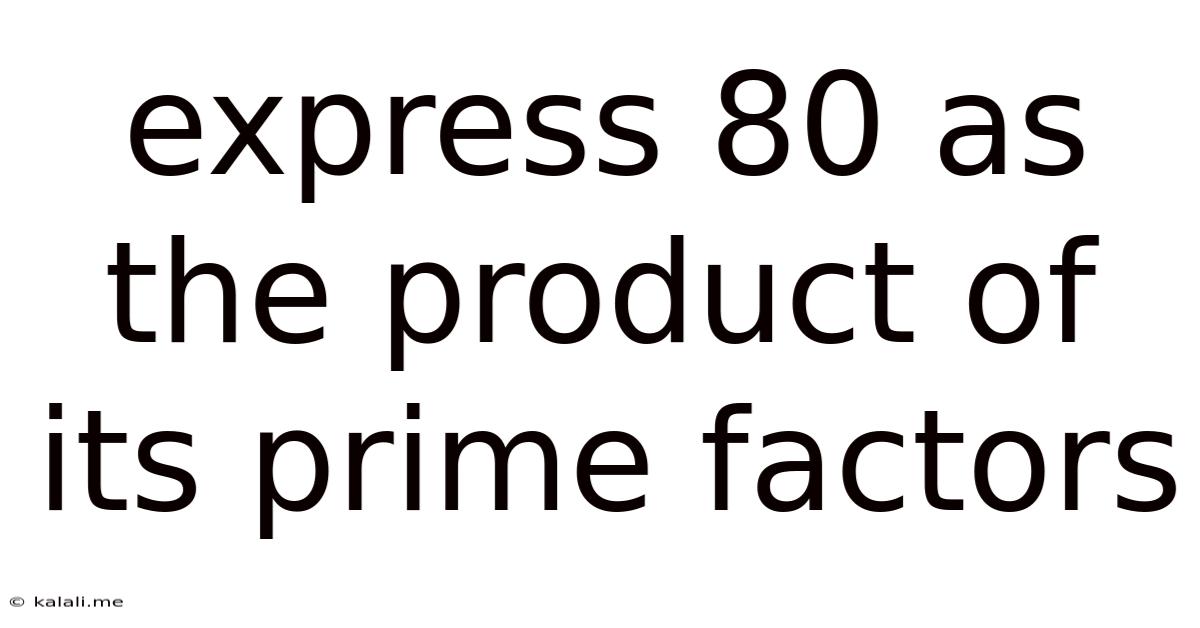Express 80 As The Product Of Its Prime Factors
Kalali
Jun 11, 2025 · 3 min read

Table of Contents
Expressing 80 as the Product of its Prime Factors: A Step-by-Step Guide
This article will guide you through the process of prime factorization, specifically demonstrating how to express the number 80 as a product of its prime factors. Understanding prime factorization is fundamental in number theory and has applications in various mathematical fields. This simple process involves breaking down a number into its smallest prime number components. Let's dive in!
What is Prime Factorization?
Prime factorization is the process of finding the prime numbers that, when multiplied together, equal the original number. A prime number is a whole number greater than 1 that has only two divisors: 1 and itself. Examples of prime numbers include 2, 3, 5, 7, 11, and so on. Every composite number (a number that is not prime) can be expressed uniquely as a product of prime numbers.
Factor Tree Method for Prime Factorization of 80
The most common method for finding the prime factors is using a factor tree. This visual method helps you systematically break down the number until you're left with only prime numbers. Here's how to do it for 80:
-
Start with the number 80. We need to find two factors that multiply to 80. A good starting point is often the smallest prime number, 2. Since 80 is an even number, we know it's divisible by 2.
-
Divide 80 by 2: 80 ÷ 2 = 40. So we have 2 x 40.
-
Continue with 40: 40 is also an even number, divisible by 2. 40 ÷ 2 = 20. Now we have 2 x 2 x 20.
-
Factor 20: Again, 20 is divisible by 2. 20 ÷ 2 = 10. Our factorization is now 2 x 2 x 2 x 10.
-
Factor 10: 10 is also divisible by 2. 10 ÷ 2 = 5. This gives us 2 x 2 x 2 x 2 x 5.
-
We've reached prime factors: Notice that all the numbers remaining (2, 2, 2, 2, and 5) are prime numbers. We can't break them down further.
Therefore, the prime factorization of 80 is 2 x 2 x 2 x 2 x 5, or 2⁴ x 5.
Alternative Method: Repeated Division
Another method involves repeatedly dividing the number by its smallest prime factor until you reach 1. Let's apply this to 80:
- 80 ÷ 2 = 40
- 40 ÷ 2 = 20
- 20 ÷ 2 = 10
- 10 ÷ 2 = 5
- 5 ÷ 5 = 1
This method also leads us to the same prime factors: 2⁴ x 5.
Conclusion
Expressing a number as the product of its prime factors is a crucial skill in mathematics. Both the factor tree and repeated division methods provide effective ways to achieve this. Understanding this process allows for solving various mathematical problems involving divisibility, greatest common divisors, and least common multiples. By practicing these methods, you'll develop a stronger foundation in number theory and improve your problem-solving abilities.
Latest Posts
Latest Posts
-
When Derivatively Classifying Information Where Can You Find A Listing
Jul 01, 2025
-
How Many Hours Is 9am To 1pm
Jul 01, 2025
-
How Fast Is 200 Km Per Hour
Jul 01, 2025
-
How Many Babies Were Conceived At Woodstock 1969
Jul 01, 2025
-
How Many Feet Is In 40 Yards
Jul 01, 2025
Related Post
Thank you for visiting our website which covers about Express 80 As The Product Of Its Prime Factors . We hope the information provided has been useful to you. Feel free to contact us if you have any questions or need further assistance. See you next time and don't miss to bookmark.